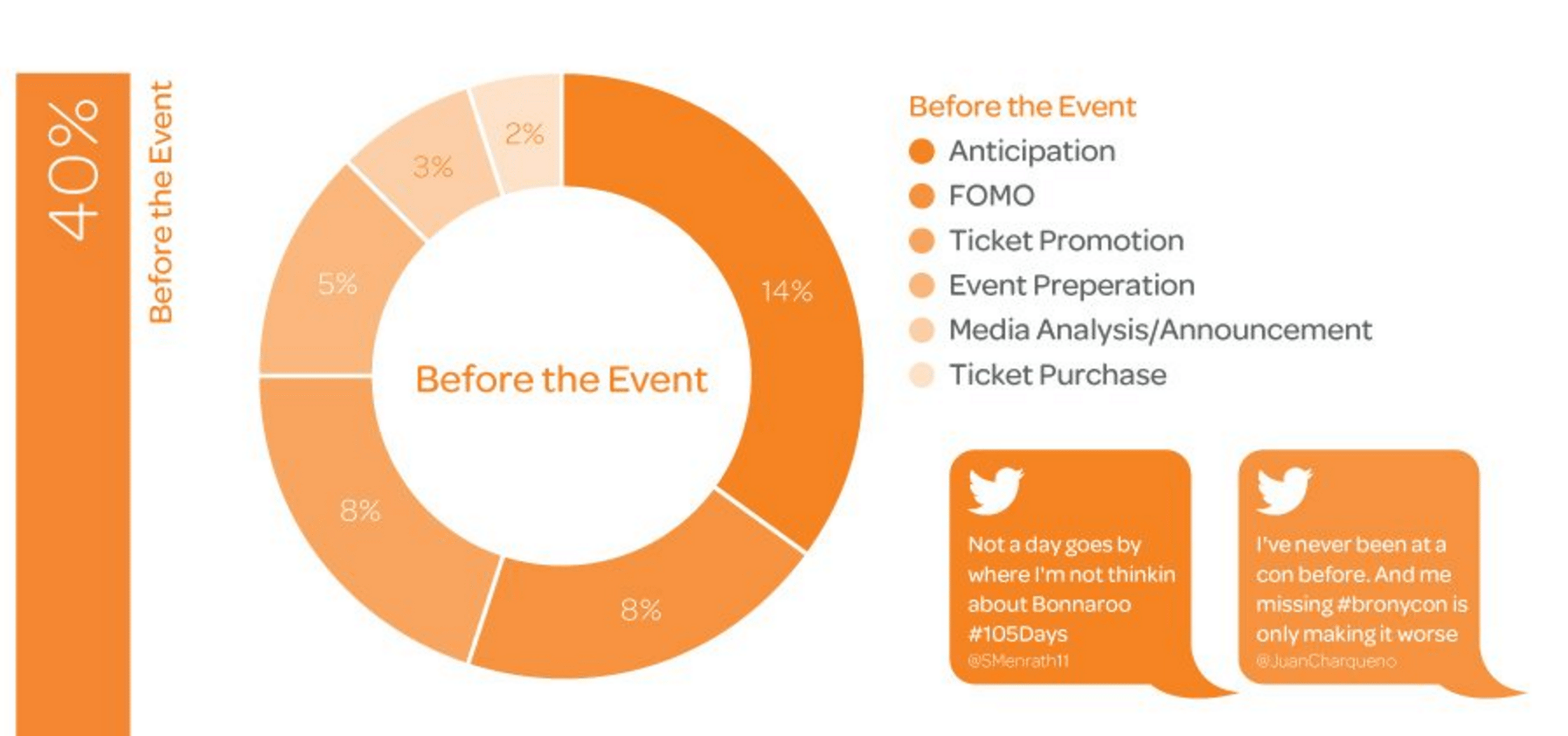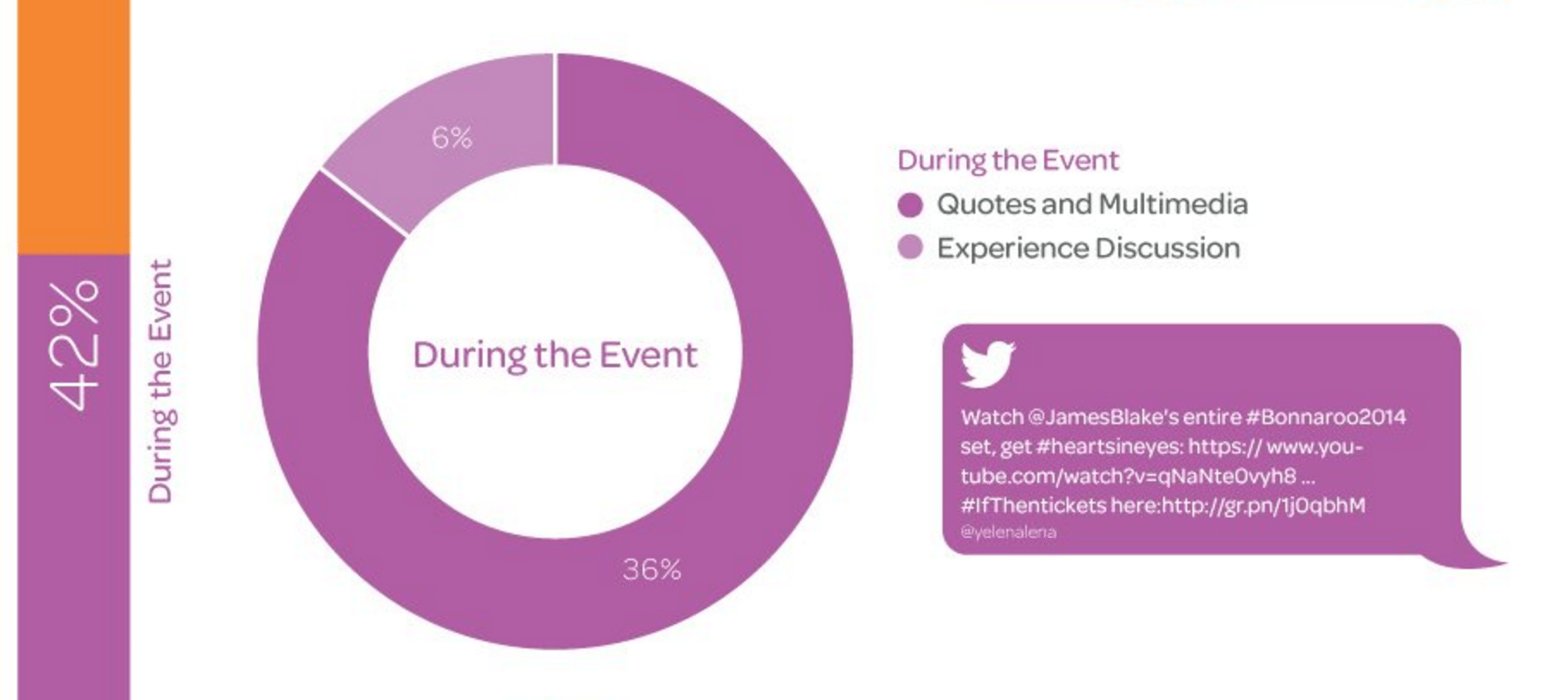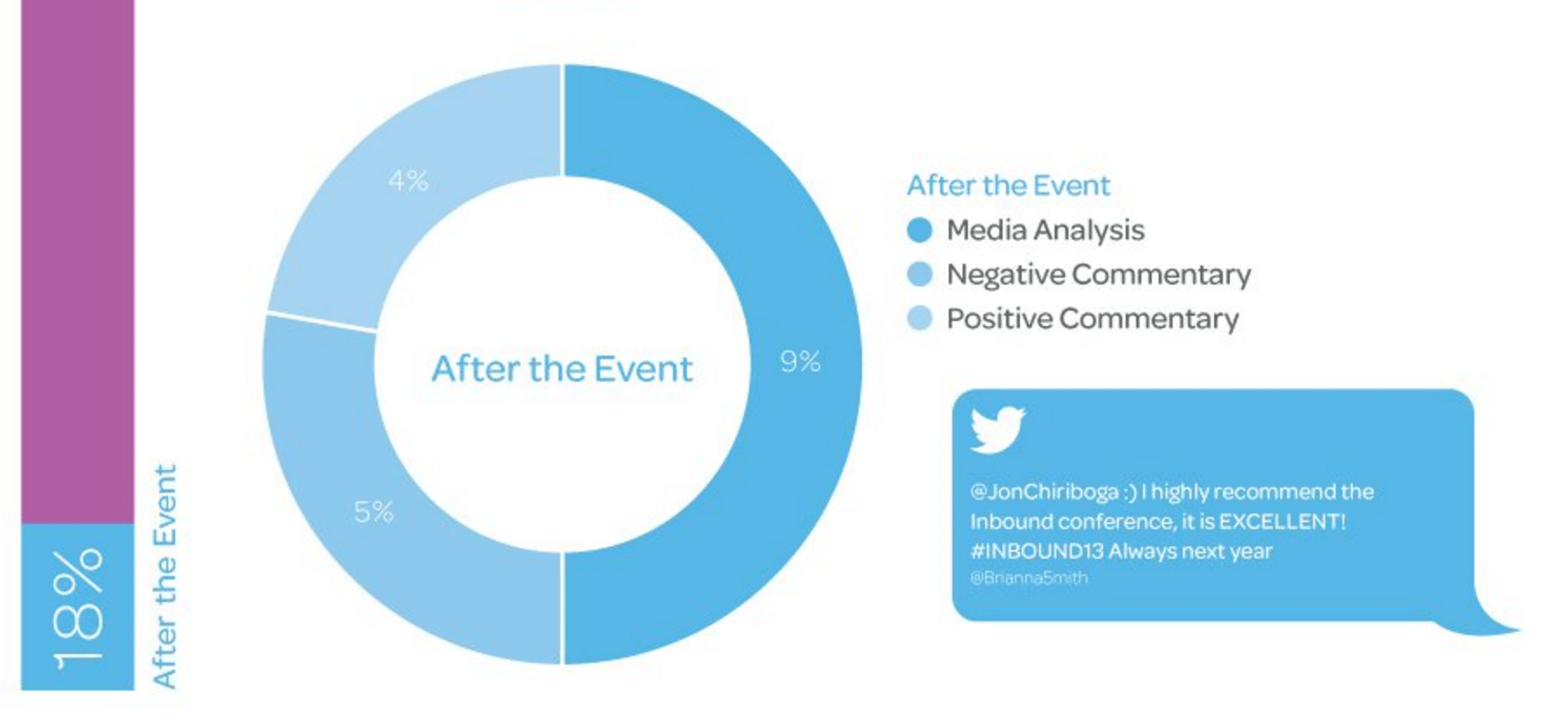Taking an event from idea to sell-out is no easy feat.
And half the battle of organizing an event is marketing it.
When it comes to the marketing channels that drive attendance, hype, and engagement, social media is right near the top. Best of all, social media event marketing isn’t as time-consuming as you may think.
You can do it! One of the greatest feelings in the world is walking into one of your own events and seeing it jam-packed with people. Social media can help get you there.
When it comes to social media event marketing, that means knowing what to post and where to post it in order to reach potential attendees. We’d love to help by sharing our biggest lessons. To discover which types of posts event-goers engage with most, our team at Eventbrite looked at over 25 million social media event posts to see just how people tweet, snap, and share about events online.
Social media event marketing: Here’s what people are talking about before, during and after events
We studied more than 25 million social media posts sent by organizers and attendees of 50 of the most popular events over a full calendar year, July 2013 to July 2014. These events included everything from music festivals (Bonnaroo) to endurance races (Tough Mudder), and we captured relevant tweets by keyword, hashtag, and Twitter/Facebook handle.
In particular, we looked at what people were talking about before, during and after events. And we found some surprising trends and some concrete takeaways for event organizers’ social media strategy.
Our top takeaways were:
- Nearly as many people are talking about an event before the event as they are during
- The largest amount of social media updates were quotes and multimedia shared during the event (36% of all updates)
- Top strategies included: Teasing the speaker lineup, providing a photo booth, creating quotes as multimedia
There was a lot of additional data and takeaways from this study, all of which we’ll be thrilled to share below. The data, originally researched through July 2014, still feels quite valid and accurate given what we’re noticing today with social media events; our current research and monitoring shows the same strategies and topics dominating the conversation.
These types of evergreen takeaways for event marketing suggest some solid strategies that have worked for companies big and small for many years.
We’d love to break this down further for you.
How to share on social before the event
Use anticipation to drive ticket sales. Here’s how.

When do you think most event attendees might tweet, snap, or post to Facebook?
Probably during the event, right?
Well, they certainly do that. But almost equal numbers of attendees and wishful attendees talk about the event in the days and weeks prior.
According to our data, there were nearly as many posts leading up to an event as there were during the event itself (40% and 42% of total posts, respectively). This makes the buildup to an event a prime time to engage both potential attendees and those who’ve registered.
To engage well, here are some tips from the ways that top brands have handled this pre-event social media marketing and and how you can apply the findings to your event’s social media strategy:
1. Reveal speaker lineups or special guests in a creative way
Anticipation and excitement accounted for 14 percent of the total posts shared on social media about events. This was the largest single percentage among any type of pre-event tweet or post.
Event-goers posted countdowns until the big day, or posted on weekdays anxiously looking forward to the event as part of their weekend plans.T – 3 days until Bay Area Brew Fest! @shatelegram #bayareabrewfest #pier35
— Avolyn Fisher (@AvolynFisher) March 9, 2016
How to build the buzz: Share creative reveals of lineups or special guests, or use teaser videos and images to increase excitement. For instance, you can post your own countdowns to the event — bonus points if you use beautiful images to motivate sharing.
2. Post often about early bird deadlines and registration windows
Nearly one out of 10 social media posts about an event has to do with ticket sales: Once they’ve committed, event-goers want to convince their friends to join them at the event and a popular way to do this is by sharing their tickets across social media.
Here’s an example of a ticket tweet, shared by a future event attendee:
Hell yeah #OutsideLands pic.twitter.com/nDgX0KrkBG
— JLD™ (@JDargenton) July 27, 2016
How to build the buzz: You can help motivate these potential attendees by using urgency to drive ticket purchases, posting whenever early bird ticket sales or registrations are about to end.
3. Perform giveaways for those with FOMO
Fans who aren’t sure if they can attend the event in person have serious FOMO (fear of missing out).
Living through your tweets tonight about the show!!! Take pics and videos so I feel like I'm there! ?❤️ #FOMO #mirandasingsalbuquerque
— gwen ballinger (@pixietangerine) July 28, 2016
How to build the buzz: Calm their fear by creating new opportunities for them to attend the event. Offer discount codes to followers on social media, or create social contests for tickets or travel stipends. You could go above and beyond with a VIP access giveaway. Make sharing your post a qualification for these giveaways to really expand your reach.
4. Share behind-the-scenes pics waaaay before the event starts
Behind-the-scenes pics are great to see what happens behind the stage. They’re also key for seeing what happens before the stage is even built!
Share these behind-the-scenes pics and stories well before the event begins is a great way to boost conversation and engagement. From our study, we saw brands and attendees doing some cool things: marathon runners sharing their training schedule, music festival fans posting their outfit choices, and travelers sharing their trip itinerary for destination events.
Got my t-shirt for tough mudder today!! Need to start training! #toughmudder #ukrunchat (sponsor me? It's in my bio) pic.twitter.com/3TugVWGjT4
— Fahima Akther (@fahimaa97) July 26, 2016
How to build the buzz: While they’re sharing their preparation, you can do the same. Make fans feel like insiders with behind-the-scenes glances at the event production. These brief glimpses can help make a personal connection with possible attendees.
By producing the type of content that event enthusiasts are already posting, you can join and help shape the online conversation. Be sure to retweet posts from excited attendees as well — their posts are free marketing to potential attendees.
How to share on social during the event
Curate the best photos and quotes. Here’s how.

The number one type of post we saw in our study of over 25 million was quotes and multimedia, during the event.
Nearly 9 million images, videos, and quotes!
So yes, while the highest percentage of social media event posts occur during the event itself, far and away the largest type of event post was multimedia-based. Eighty-five percent of the in-event posts included multimedia elements, such as images, videos, and quotes. Only 15% were plain text.
The takeaway here: You can look for ways to make your event photo-worthy to encourage attendees to post during the event.
Here are a few ways you can make your event photo-friendly:
1. Have a photo booth
Create a photo booth area, and pay attention to little details that would make great Instagram shots or Snapchat snaps.
At the TNW Europe conference, there was a photo booth allowing attendees to take and share fun images. Notice the cool branding stripe across the bottom of the picture:
Have a blast at #TNWEurope? Check the photo albums, including ones from @thesnapcube: https://t.co/GNkTs5bHEC ? pic.twitter.com/rX1jQ8jvss
— #TNWEurope (@TNWconference) June 8, 2016
And Disney used a photo booth to enable attendees of the latest Captain America film to share the moment:
Letzte Woche auf der "The first Avenger" Filmpremiere in Berlin#thesnapcube meets #CaptainAmericaCivilWar pic.twitter.com/qyU9Pu855j
— snapcube (@TheSnapcube) April 27, 2016
2. Share content from speakers
If you host an event with speakers, like a conference or fundraiser, you can tweet or post the key quotes from speakers to encourage sharing. Tagging the post with your event’s hashtag and @-mentioning the speaker may help this content spread virally as well — both with event attendees and with any folks watching from home.
Here’s a great example from the Digital Marketing World Forum:
Great closing session from @B1an ! #DMWF pic.twitter.com/WuqoqRNnr6
— #DMWF (@DigiMarketingWF) June 21, 2016
If you’d like to create content like this for your event, it can be great to prepare ahead of time so that you can get your quotes out there in real-time as your event takes place. Another fast option is to use Canva to create this type of content in real-time – and best of all, you don’t need to be a designer to create beautiful, engaging images.
3. Take followers behind-the-scenes with backstage pics and video
You can also create your own engaging multimedia posts to entice sharing during the event. Share photos and videos that give people a look backstage, or highlight exclusive interviews with people at the event. Photos are great for all networks, Facebook Live video is an awesome real-time resource, and Snapchat or Instagram stories make sense for those in-the-moment moments.
The Next Web did a great job with this at their recent conference in Amsterdam by using Snapchat and cross-promoting content to other networks like Twitter:
? BEHIND THE SCENES look at @caseyneistat backstage at #tnweurope… Only on Snapchat: https://t.co/AAp4lDF3Na pic.twitter.com/nffwnBqu73
— #TNWEurope (@TNWconference) May 27, 2016
4. Interact with your audience using questions and polls
You can also use interactive content like questions or polls to ask attendees which performer, booth, or speech they loved most. Have someone on your team designated to respond to any questions, issues, or comments that people send your way.
Twitter polls is perhaps the sleekest poll option for doing this quickly or in real-time.
We're curious: do you use an ad blocker?
— Nieman Lab (@NiemanLab) October 28, 2015
If you’re planning to create some interactive content, it can be good to think about the questions you’d like to ask and what content you’d like to produce beforehand. This can greatly increase the quality of the content you’re putting out and also help to reduce stress levels on the busy days when your event is live.
How to share on social after the event
Celebrate your press mentions and ask for feedback. Here’s how.

Just because your event is over doesn’t mean the online conversation is. Though it accounted for the smallest volume of social media updates, the after-event conversation still made for 18% of the total number — nearly 1 out of every 5 social posts were in follow up from the event.
The main two reasons we found people were talking about events after they happend were: press coverage and feedback. Here’s a little more on each of those:
1. Press coverage
The largest portion of this after-event conversation was media coverage of events (9% of total posts). This is your chance to celebrate all that you accomplished — so go ahead and brag a little by sharing all the great press you’ve gathered.
If you’re aiming to get some coverage after the event, it could be best to reach out to some journalists in your space and invite them to the event in order to experience it for themselves.
2. Ask for feedback
The rest of post-event conversation is divided between positive and negative feedback for the event. Share and revel in the positive feedback, but don’t ignore the negative. Respond by thanking critics for their thoughts, and take their feedback into account when planning your next event.
To make this feedback more actionable, you could share a post-event survey with followers to find out how to make your next event even better. Be open with your followers about how you listened to them to make changes, and they’ll be even more excited to buy tickets for next time.
If anyone is seriously disgruntled, you can also offer discounts for your next event to help smooth the waters. (Discounts are also a great way to encourage loyalty with happy event-goers.)
Over to you
Thanks so much for reading! We’d love to hear if these findings feel accurate to for any events you’ve been a part of.
Does this reflect the conversation you see on social media about your event? What types of content do you post before, during, and after events to engage your audience? It’d be great to hear from you in the comments!
Try Buffer for free
190,000+ creators, small businesses, and marketers use Buffer to grow their audiences every month.


